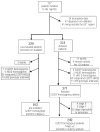The Southern French registry of genetic hemochromatosis: a tool for determining clinical prevalence of the disorder and genotype penetrance
- PMID: 20145272
- PMCID: PMC2857184
- DOI: 10.3324/haematol.2009.014431
The Southern French registry of genetic hemochromatosis: a tool for determining clinical prevalence of the disorder and genotype penetrance
Abstract
Background: Despite great progress in understanding the mechanisms underlying genetic hemochromatosis, data on the prevalence and the penetrance of the disorder are conflicting.
Design and methods: A registry of patients with genetic hemochromatosis was established in the South of France and a regional health network was developed to allow the inclusion of all the diagnosed patients. C282Y homozygous patients classified in stages 2 (biological iron overload), 3 and 4 (clinical manifestations of iron overload, stage 4 being the more severe) according to the classification of the French National Authority for Health were included in the registry over a 6-year period.
Results: A total of 352 symptomatic C282Y homozygotes were identified, resulting in a total prevalence of 1.83 per 10,000 (95% CI: 1.63 to 2.02) in subjects over 20 years and 2.40 per 10,000 (95% CI, 2.15 to 2.65) among subjects of European descent. Among Europeans, the total calculated penetrance was 15.8% in stage 2 or higher, 12.1% in stage 3 or 4 and 2.9% in stage 4. The penetrance was slightly higher in males (18.7%) than in females (13.2%). It was 19.9% for individuals over 40 years of age (24.1% and 16.3% in males and females, respectively) with a maximum of 31% in subjects between 50 and 54 years old. Among 249 patients with complete records, 24% were in stage 2, the majority (58%) were in stage 3, and 18% in stage 4. There was a higher proportion of males, and excessive alcohol intake was more prevalent in stage 4 than in stages 2 and 3 combined.
Conclusions: A French Mediterranean regional hemochromatosis registry with strict inclusion criteria is a useful tool for characterizing the history of this disease, particularly for the most severely affected patients, as defined by the disease severity classification. The total prevalence of symptomatic C282Y homozygotes in the region was found to be low. However, clinical penetrance (stages 3 and 4) was not negligible.
Figures

Similar articles
-
Correlation between iron status and genetic hemochromatosis (codon C282Y) in a large German population.Isr Med Assoc J. 2004 Jan;6(1):30-3. Isr Med Assoc J. 2004. PMID: 14740507
-
Iron-overload-related disease in HFE hereditary hemochromatosis.N Engl J Med. 2008 Jan 17;358(3):221-30. doi: 10.1056/NEJMoa073286. N Engl J Med. 2008. PMID: 18199861
-
Hereditary hemochromatosis in a Brazilian university hospital in São Paulo State (1990-2000).Genet Mol Res. 2005 Mar 31;4(1):31-8. Genet Mol Res. 2005. PMID: 15841433
-
Clinical penetrance of C282Y homozygous HFE hemochromatosis.Expert Rev Hematol. 2008 Dec;1(2):205-16. doi: 10.1586/17474086.1.2.205. Expert Rev Hematol. 2008. PMID: 21082925 Review.
-
Contribution of different HFE genotypes to iron overload disease: a pooled analysis.Genet Med. 2000 Sep-Oct;2(5):271-7. doi: 10.1097/00125817-200009000-00001. Genet Med. 2000. PMID: 11399207 Review.
Cited by
-
The Evolution of Iron-Related Comorbidities and Hospitalization in Patients with Hemochromatosis: An Analysis of the Nationwide Inpatient Sample.Blood Sci. 2023 Jan 17;5(2):131-135. doi: 10.1097/BS9.0000000000000151. eCollection 2023 Apr. Blood Sci. 2023. PMID: 37228771 Free PMC article.
-
The clinical management of hereditary haemochromatosis.Frontline Gastroenterol. 2018 Apr;9(2):110-114. doi: 10.1136/flgastro-2017-100872. Epub 2017 Sep 23. Frontline Gastroenterol. 2018. PMID: 29588838 Free PMC article. Review.
-
Iron overload in HFE C282Y heterozygotes at first genetic testing: a strategy for identifying rare HFE variants.Haematologica. 2011 Apr;96(4):507-14. doi: 10.3324/haematol.2010.029751. Epub 2011 Jan 12. Haematologica. 2011. PMID: 21228038 Free PMC article.
-
An efficient machine learning-based approach for screening individuals at risk of hereditary haemochromatosis.Sci Rep. 2020 Nov 26;10(1):20613. doi: 10.1038/s41598-020-77367-6. Sci Rep. 2020. PMID: 33244054 Free PMC article.
-
Factors influencing disease phenotype and penetrance in HFE haemochromatosis.Hum Genet. 2010 Sep;128(3):233-48. doi: 10.1007/s00439-010-0852-1. Epub 2010 Jul 6. Hum Genet. 2010. PMID: 20607553 Review.
References
-
- Smith PM, Godfrey BE, Williams R. Iron absorption in idiopathic haemochromatosis and its measurement using a whole-body counter. Clin Sci. 1969;37(2):519–31. - PubMed
-
- Feder JN, Gnirke A, Thomas W, Tsuchihashi Z, Ruddy DA, Basava A, et al. A novel MHC class I-like gene is mutated in patients with hereditary haemochromatosis. Nat Genet. 1996;13(4):399–408. - PubMed
-
- Beutler E, Felitti VJ, Koziol JA, Ho NJ, Gelbart T. Penetrance of 845G-->A (C282Y) HFE hereditary haemochromatosis mutation in the USA. Lancet. 2002;359(9302):211–8. - PubMed
Publication types
MeSH terms
LinkOut - more resources
Full Text Sources
Medical

